Unit - 3
Transmission systems
Q1) What is transmission system?
A1)
It is the mechanism which transmits the power to the driving wheels which is developed by the engine of an automobile. It is also called Power Train. It constitutes:
• Tyres
• Propeller shaft
• The gear box
• Wheel
• Rear axle
• Universal joints
• Clutch
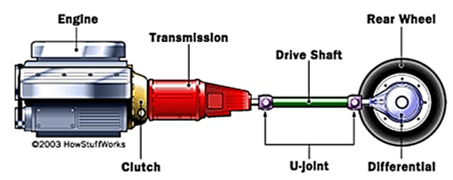
Fig 1 Components of Transmission system.
Q2) What is requirement of transmission system?
A2)
Requirements: -
• It can sustain the consequence of torque forces, driving thrust and braking force efficiently.
• It provides means to drive the driving wheels at dissimilar velocities when necessary.
• It enables flow of power at 90 (right) angles.
• It must enable transmission of power at different angles and lengths.
• It enables speed reduction between engine and the drive wheels in the ratio of 5:1.
• It offers ways to transmit power in opposed direction.
• It provides a varied leverage between the engine and the drive wheels
• It offers linking and de-linking of engine with other members of power train effortlessly and devoid of shock.
The main units of the transmission system according to the above requirements are as follow:
• Clutch
• Propeller Shaft and Universal Joints.
• Gear Box
• Transfer Case
• Final Drive
• Differential
• Torque Tube
• Road Wheel
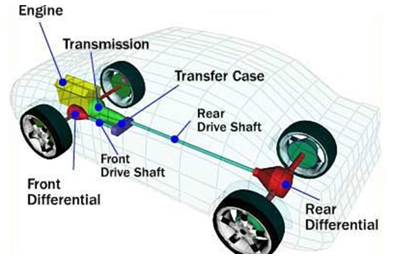
Fig 2 Main units of Transmission System.
Q3) What is clutch?
A3)
- In phrases of mechanical engineering, a grab is that sort of tool which utilized by engineers to interact in addition to disengage transmission of electricity from a using shaft to a pushed shaft.
- In the mechanism of a grab, the using shaft is without delay linked to an engine while the alternative one or the pushed shaft offers the electricity output this is used by the consumer for working.
- Often instances clutches are used to restriction the movement or quantity of electricity transmission among components.
- A not unusual place instance of a grab is that it's far utilized in cars for enticing in addition to disengaging gearbox and the engine of the automobile.
Q4) What are the types of clutches?
A4)
Types of Clutches:
In mechanical engineering distinct sorts of clutches are present. Numerous sorts of clutches are utilized in a couple of functions through engineers, despite the fact that each kind has it is.
The running precept of various sorts of clutches is likewise distinct in nature this is why on this segment of this assessment, distinct sorts of clutches are mentioned in brief to offer an in depth view.
- Friction Clutch
- Single Plate Clutch
- Multi Plate Clutch
- Cone Clutch
- Centrifugal Clutch
- Semi-centrifugal Clutch
- Diaphragm Clutch
- Dog and Spline Clutch
- Electromagnetic Clutch
- Vacuum Clutches
- Hydraulic clutch
- Freewheel Clutch
Q5) Write a note on cone clutch.
A5)
Cone clutch
Cone Clutch is a type of frictional capture. It is used to engage and disengage engine shaft to the transmission discipline shaft even as changing equipment ratio. Cone capture makes use of conical surfaces to transmit torque with the useful resource of the use of friction.
Cone capture is much less complex to engage and disengage in comparison to a pleasant displacement capture which modified into used in advance than cone clutches have been invented. Higher torque can be transferred using the cone capture than same period of plate capture due to greater contact area. The driving shaft and the driven shaft want to be perfectly coaxial for inexperienced functioning of the capture. This capture can be used wherein immoderate torque transmission is wanted at low rotating speed. So, this type of capture is extensively is heavy vehicles.

Fig. Cone Clutch
Parts of Cone Clutch:
1. Female Cone or Outer Cone:
It is the part of the cone grasp this is linked to the flywheel of the engine and additionally rotates with it. This component identity notification continually in rotating circumstance because the engine shaft rotates continuously. Female cone has internal slicing cone-fashioned groove which has friction lining over which the male cone interlocks and make frictional touch with it in an effort to have interaction the drive. This lady cone is installed over stable shaft.
2. Male Cone or Inner Cone:
This cone is hooked up to the transmission device or the gearbox. Inner cone has friction lining with inside the outer component which creates frictional touch with internal friction lining of the outer cone. By default, internal cone stays in touch with the outer cone with the assist of strain springs that is located at the back of the internal cone. When the grasp pedal is pressed in situations like converting gear, the spring is compressed and the internal cone actions far from the outer cone and disengages from the outer cone and consequently the engine is disengaged from the transmission box. This internal cone has internal splines and actions over slices of shaft for to and from motion.
3. Springs:
Springs are positioned in the back of the male cone which can be used to hold the internal cone engaged with outer cone. When the seize pedal is pressed, the spring compresses and the internal cone disengages with outer cone and consequently the driving shaft is disconnected from pushed shaft.
4. Sleeves:
Sleeves are the part of the seize that is connected to the male cone and installed at the splines and those sleeves are used for back and forth movement of male cone.
5. Pedal:
A seize pedal is used to function the seize.
Q6) Explain the working of cone clutch.
A6)
Working:
By default, the male cone is engaged with the woman cone because of the strain of the spring that's gift at the back of the male cone. When the take hold of pedal is pressed so that it will extrude the tools or for a few different cause, the fulcrum that's connected to pedal rotates which in flip compresses the spring and additionally the male cone is pulled far from the woman cone. Thus the touch among the male cone and woman cone will break.
So, the engine shaft may be disengaged from transmission device and rotation of engine shaft or using shaft will now no longer be transferred to the transmission shaft or the pushed shaft. Now after the disengagement whilst the take hold of pedal is launched slowly with the aid of using the motive force after converting the gears, the fulcrum that's connected to the pedal rotates and the spring expands and the male cone begins off evolved transferring closer to the woman cone over splines.
After that, the male take hold of make touch with the woman take hold of and friction pressure act among the internal friction lining of outer cone and outer friction lining of internal cone. Now the cone take hold of is stated to be in have interaction role and the rotation of engine shaft or using shaft is transferred to the transmission shaft or pushed shaft and each the shaft begin rotating at equal speed. The stiffness with the aid of using the spring continues the male cone and woman cone of the cone take hold of in engaged role.
Advantages:
1) The ordinary pressure performing on touch floor is more than the axial pressure.
2) Higher torque may be transferred than the identical length of plate grab because of huge quantity of frictional pressure involved.
3) It creates much less noise than plate grab.
4) Less put on and tear compared to displacement grab.
Q7) What do you mean by single plate clutch?
A7)
Single Plate Clutch (SPC)
- The diagram of SPC is given below in Fig. 4, with the friction plate placed between the flywheel and the pressure plate.
- Springs are provided tangentially offering axial force keeping the clutch in the engaged position.
- The second friction plate is attached on a hub (split from the inside) and thus the gear box is free to slide on the shaft. Friction is encountered from the friction plate on either side to provide two annular friction surfaces for the transmission of power.
- Clutch pedal is also there which pulls the pressure plate against the spring force every time detachment is required. It usually continues to be in engaged position (Figure 4).
- As the pedal is depressed, the pressure plate moves to the right opposite to spring force. This is achieved through a suitable linkage (not shown in Figure 4) and a thrust bearing. As such, the friction plate and clutch are released.
- In real sense, the clutch construction varies. The plate (pressure), springs, releasing lever and cover forms a cover assembly, that can be fixed straightly to the engine block, with the clutch plate placed between the flywheel and the pressure plate.
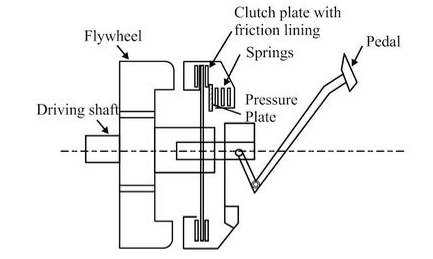
Fig 4 Single Plate Clutch.
Q8) Explain multi plate clutch in detail.
A8)
Multiplate Clutch (MPC)
- This type of clutch is a modified version of SPC where friction and number of metallic plates are increased.
- Due to growth of frictional surfaces, the ability of the clutch to transmit torque increases.
- The overall diameter of the clutch is reduced for torque transmission similar to a single plate clutch. Hence, MPC is applicable where high torque transmission is required like various heavy automobiles and racing cars.
- This is also used in scooters and motorcycles, due to space limitation.
- The framework is comparable to the SPC, exception being that, the friction plates are in 2 pairs, i.e., one pair of plates slips into the groove on the flywheel and the other a pressure plate slides onto the hub splines. Alternative plates belong to each set.
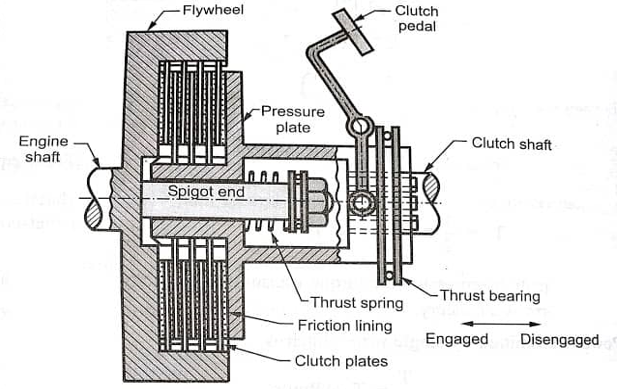
Fig 5 Multiplate Clutch
Working of MPC is divided into 2 steps as discussed below:
Engagement
- As the paddle is pressed, the engagement takes place in the engine and the movements of the thrust springs is enhanced.
- Thrust springs offers pressure to the pressure plates making the pressure plate to move in forward direction.
- Also, the linings which are placed on the inner side of the pressure plate make contact with the flywheel, start its action.
- Consequently, the clutch engages.
Disengagement
- For disengagement of engine and clutch, the clutch pedals as well as the fins of inner splined sleeves are pressed.
- Thrust spring moves in backward direction releasing pressure from the pressure plates and plate also moves backward.
- Consequently, due to released pressure from the flywheel, plate and springs the clutch disengages.
Q9) What is diaphragm spring?
A9)
Diaphragm Spring:
Eaton gives an extensive kind of diaphragm spring clutches to match pretty much any business automobile application. Built to strict OEM best standards, they make sure first-rate overall performance and grab existence. Their strong and easy walking layout reduces idling noise and might notably lessen extreme vibrations, extending drivetrain thing existence and the sturdiness of transmission synchronizers.
Working:
Figure indicates the development information of the diaphragm take hold of. It includes a diaphragm spring that is supported on a fulcrum preserving ring i.e. pivot ring in order that any phase thru the spring may be appeared as a easy lever. In the engaged role, the spring pivots at the rear pivot jewellery as it's far held in a take hold of cowl in order that its outer rim contacts the stress plate.

Fig 6. Diaphragm clutch
Therefore, enough stress is exerted with the aid of using the spring creating a company touch among stress plate and take hold of plate in addition to the flywheel in its herbal conical role. To disengage the take hold of, the pedal is depressed to purpose the linkage to transport throw-out bearing toward the flywheel. As the bearing contacts the internal role of the conical spring, it movements ahead which reasons the rim to transport backward because the spring pivots at the front pivot ring. It eliminates the stress at the stress plate and releases the take hold of disc from touch with each using members.
Features:
- Available in plenty of sizes from 280 millimeters to 430 millimeters
- Engineered and synthetic to unique gadget specifications
- Single or dual plate designs
- Soft-price dampers assist defend in opposition to dangerous torsional vibrations and growth the sturdiness of transmission synchronizers and driveline components
- Smooth engagement and much less pedal effort Available pre-dampers cast off rattle at idle
Q10) Explain centrifugal clutch.
A10)
Centrifugal Clutch:
Centrifugal Clutch is a kind of grasp wherein centrifugal pressure is used to attach the engine pressure shaft with the shaft of the transmission. It is located in among the engine flywheel and the transmission system. Its important feature is to attach the engine shaft with the transmission shaft. It works extra successfully at better speeds.
Parts of centrifugal clutch:
- Shoes:
It includes friction lining on the stop and this friction lining makes touch with the drum for the duration of the engagement.
2. Spring:
Spring is used to disengage the snatch while the engine rotates at a slower speed.
3. Spider or publications:
The spiders are established at the driver (engine) shaft or motor shaft. The spiders are similarly spaced. Equally spaced means, if they may be 4 publications than every manual is separated from every different through ninety degree. The sliding footwear are saved in among those publications and every manual is maintaining a spring.
4. Friction lining:
The outer floor of sliding footwear has friction lining. It allows in creating a grip with the internal floor of the drum.
5. Drum:
The drum of the snatch act as housing which encloses all of the components of the snatch that consists of sliding footwear, publications, springs etc. It is attached to the pushed shaft of the transmission gadget or chains or belt.
Working:
- As the engine rotates, the interior meeting of the centrifugal snatch begins off evolved rotating however drum stays desk bound and no electricity is transmitted.
- At decrease pace, the centrifugal pressure produced isn't enough to triumph over the spring pressure. So the snatch stays disengaged. But as the velocity will increase, the centrifugal pressure additionally will increase and now the centrifugal pressure will become more than the spring pressure.
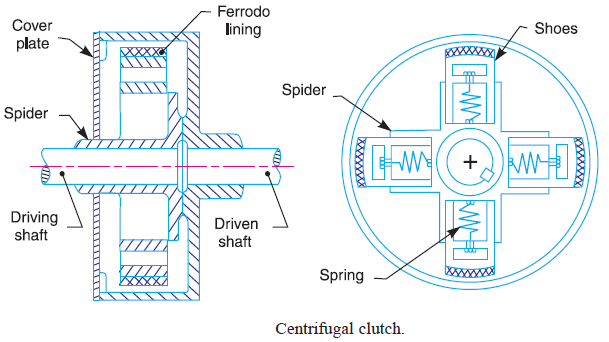
Fig 7. Centrifugal Clutch
- As the centrifugal pressure will become more than the spring pressure, this lets in the sliding footwear to transport outward in opposition to the spring and get engaged with the internal floor of the drum.
- The drum begins off evolved rotating and transfers the rotating electricity from the engine to the pushed shaft of the transmission. When the burden at the engine will increase, its pace decreases and disengages the snatch.
Q11) Write a note on electromagnetic clutch.
A11)
- The working precept of the actuator of electromagnetic snatch is an electromagnetic effect, however torque transmission is mechanical.
- The distinction among electromagnetic snatch and the everyday snatch is in how they manipulate the motion of strain plates.
- In the ordinary snatch, a spring used to interact the snatch while in EM snatch an electromagnetic area is used for engagement.
- The electromagnetic snatch comes numerous forms, such as magnetic particle snatch and multi-disc snatch.
- There are even no-touch clutches which include hysteresis snatch and eddy cutting-edge snatch. However, maximum broadly used shape is unmarried face friction snatch.
Construction:
Rotor:
Rotor is a primary a part of this snatch witch is hooked up at once to the riding shaft or engine shaft. It constantly rotate alongside the riding shaft.
Winding or Coil:
Winding coil is located at the back of the rotor and stays in desk bound function for the duration of snatch working. It is proven in figure. A excessive voltage DC deliver is hooked up with this winding which switch a excessive voltage present day into this winding and convert it into electromagnet.
Armature:
Armature is located at the front of the rotor. It is hooked up to the hub or stress plated with the assist or rivet or bolted joint.
Hub:
Hub or stress plate is bolted with the tools shaft or pushed shaft and rotates with it. It is located after the armature.
Friction Plate:
Friction plate is inserted among armature and rotor in keeping with the requirement.
Supply unit:
Supply unit consist snatch switch, battery, cord etc.
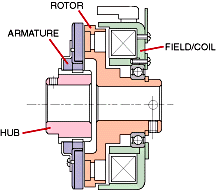
Fig 8: Electromagnetic Clutch
Working of electromagnetic clutch
- The predominant additives of EM take hold of are a coil shell, an armature, rotor, and hub.
- The armature plate is covered with friction coating. The coil is positioned at the back of the rotor.
- When the take hold of activated the electrical circuit energizes the coil, it generates a magnetic area. The rotor part of take hold of receives magnetized.
- When the magnetic area exceeds the air hole among rotor and armature after which it pulls the armature towards the rotor. The frictional pressure generated on the touch floor switch the torque.
- Engagement time relies upon at the electricity of magnetic fields, inertia, and air hole. When voltage is eliminated from the coil, the touch is gone.
Q12) Explain manual gear shift mechanism.
A12)
Manual Gear Shift Mechanism:
A guide transmission offers you a opportunity to shift gears manually. It consists of moving mechanism, synchronizers, intermediate, enter and output shafts, auxiliary shaft, casing and opposite equipment. The majority of gearboxes of this kind have 4 or 5 gears and one opposite.
As for the relaxation of advantages, right here they are: This kind stands proud for its enviable existence cycle. A guide transmission may even out survive the existence of the automobile’s engine.
- Excellent fuelling mileage.
- When in comparison with an automated transmission, the automobile with the guide one consumes 15% much less gasoline and has better acceleration dynamics.
- High efficiency – a guide transmission makes it viable to apply all to be had torque-wearing capacity.
- Ood vehicle behaviour – you could adjust the equipment moving system with the aid of using your own, deciding on the maximum snug using style. Low weight (decrease than that of an automated transmission).
- Possibility to begin up the engine regardless of the discharged battery and low-appearing ignition.
Possibility to tow a vehicle each via inflexible and bendy towline. Speaking approximately its disadvantages, it ought to be cited that the exploitation of forms of guide transmission may be pretty tough for beginners. A driving force will must use it in tandem with the clutch, so there may be a massive risk to disrupt it with the aid of using creating a rookie mistake. On pinnacle of that, in case you forgot to shift equipment, it is able to motive a few engine lug. Another component is that town using will make you shift gears manually all of the time.
Q13) Write a note on automatic gear shift mechanism.
A13)
Automatic Gear Shift Mechanism:
The production of all automated equipment bins is a long way extra complicated than that of guide ones. It includes extra gadgets and parts, so its purchase, installation, exploitation and restore don’t come cheap.
But this transmission is higher suitable for metropolis driving. It is exceedingly desired with the aid of using beginners, on the grounds that this form of gearbox in vehicle eliminates the need to tug the lever and use the seize all of the time.
The equipment pump is located among the planetary gear set and torque converter, wherein it pulls and pressurizer’s transmission fluid from a sump.
The pump enter leads at once to the housing of the torque converter connected to the flex plate of the engine. When the engine isn't always running, the transmission does now no longer have the oil strain had to function and as a result the car cannot be push-started.
The planetary equipment educate is a mechanical device wherein the gears are related with a hard and fast of bands and clutches.
When the driving force modifications gears, the bands maintain one equipment nonetheless at the same time as rotating some other to transmit torque from the engine and boom or lower gears.
Q14) Write a note on working principle of overdrive in automobile.
A14)
Working Principle of Overdrive in Automobile:
- The overdrive is to be positioned in among the Gearbox and the Propeller shaft. The characteristic of overdrive is to growth extra quantity of energy than the energy added from the gearbox. On the enter shaft, the Sun equipment is hooked up via Spline.
- The freewheel has an inner spline and the Input shaft has an outside Spline and those will mesh together. Whenever there may be a spline joint, the Freewheel does now no longer go through any rotary relative movement however it has handiest horizontal relative movement.
- In the sense, the Freewheel can circulate handiest with inside the horizontal route however cannot rotate on the middle of the enter shaft. Whereas the solar equipment is freely established at the enter shaft.
- It method that, every time the shaft is rotating, the Sun Gear can also additionally or might not rotate however the Freewheel has to transport w.r.t. The enter shaft handiest. The Sun Gear meshes with the planet gears and this planet gears are in touch with the Planet Carrier.
- The Planet Gear is likewise in touch with the hoop equipment and from the hoop equipment, the energy is despatched to the output shaft.
Q15) What is transfer box?
A15)
Transfer container is part of a 4-wheel-power device utilized in 4-wheel-power or all-wheel power vehicles. It is likewise referred to as “switch equipment case”, “switch gearbox”, “switch container”, ‘jockey container” or “T-case”. The feature of switch container is to distribute the torque generated in engine to all 4 wheels of the automobile.
The switch container is hooked up to the engine, the front axles and rear axles thru power shafts. The switch equipment container is managed via way of means of the driver. The manipulate is placed with inside the automobile compartment. It is both with inside the shape of a switch lever or a button.
Construction of Transfer Box:
- The enter shaft is attached to the tools container and consists of on it a member having axial tooth.
- Two enter shaft gears are unfastened to rotate at the shaft. Each of those gears have bosses at the fact that have axial tooth of the identical pitch because the imperative member at the enter shaft.
- Depending upon the motion of the switch container tools lever, the imperative member and thereby the enter shaft can be linked both to the small tools and to the large tools.
- There are output shafts, one going to the front axle and the second one going to the rear axle.
- The front output shaft has geared up on it a shifter mechanism and additionally has splines over a small duration of it, which while have interaction with the corresponding inner splines at the rear output shaft, join the 2 shafts rotationally with every other.
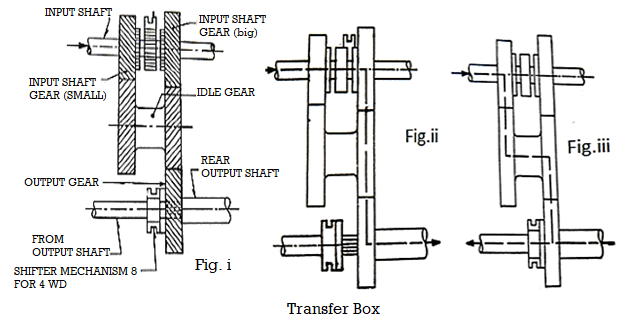
Working Of Transfer Box:
When the shifter mechanism A is with inside the centre in order that no tools is attached to the enter shaft, the power is in impartial as proven in Fig.i. Fig. Ii suggests whilst the shifter mechanism A connects the enter shaft with the large enter tools, however the shifter mechanism B disconnects the front output of shaft from the rear output shaft.
In this position, two-wheel power with the excessive tools is obtained. In the identical manner Fig.iii depicts the state of affairs with 4 wheel power in low.
Q16) Explain transaxle in detail.
A16)
- The transaxle may be orientated both transversely and longitudinally. The transverse axles are utilized in live performance with the transverse engines in lots of cutting-edge the front-wheel pressure cars.
- This is a configuration that locations the whole pressure teach in addition to the pressure wheels on the front quit of the car. On the alternative hand, a whole lot of the rear-wheel-pressure cars additionally use the longitudinal engine geared up with a traditional transmission in addition to a drivetrain. However, on this sort of set-up, they both have a mid or rear-engine set-up.
- When the engine is installation on the rear, the whole configuration is pretty much like the only on an FWD vehicle.
- Also, there are numerous approaches to strengthen the power of transmission rather than the usage of a transaxle. While in principle there exists transaxles designs that would take care of ultra-effective engine designs, their compact nature poses a few extreme engineering challenges.
- Transmissions, on the alternative hand, have greater room for cautious design. Moreover, the separate rear differential way that you can effortlessly switch it out for an upgraded one. There additionally exists rear-wheel drive (RWD) cars that include transaxles too. Instead of becoming beside the engine, the transaxle is located with inside the rear wherein the rear differential desires to be.
- It isn’t normal, however it enables in higher weight distribution disposing of the want for a rear differential as well. Generally, transaxles will now no longer include guide transmission because of the manner they may be packaged, and could nearly continually be automatic.